Turn on red

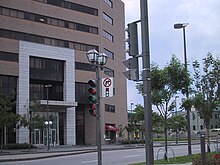
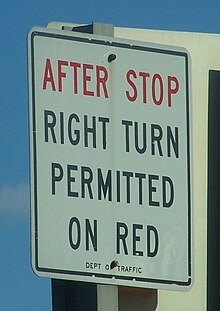
In the United States outside New York City,[2] right turns are permitted on red (except for school buses transporting pupils in New York State)[3] unless there is a "No Turn on Red" or a "Right Turn Signal" light indicating the same and controlling the right turn.
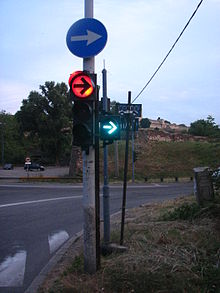
Turn on red is a principle of law permitting vehicles at a traffic light showing a red signal to turn into the direction of traffic nearer to them (almost always after a complete stop, depending on the jurisdiction) when the way is clear, without having to wait for a green signal.
North American traffic engineers first introduced this rule as a fuel savings measure in the 1970s, despite detrimental effects to the safety of pedestrians.[4] Canada and The United States are some of few major countries where turning on red is generally allowed.[5] Amid a push to reduce pedestrian fatalities and make cities safer for pedestrians and bicyclists, some American localities have in recent years implemented bans on turning on red.[6][7]
Turns
[edit]Right on red
[edit]The simplest version is commonly known as a right turn on red (or simply right on red) in countries that drive on the right side of the road, or a left turn on red in countries that drive on the left side of the road.
A right turn requires checking only two nearby crosswalks (at least one of which will show "don't walk") and vehicular traffic moving towards the driver, while a left turn or going straight requires checking two crosswalks and vehicular traffic moving in multiple directions.
When turning right on red, the vehicle typically has to yield to traffic coming from the left, and the crosswalk parallel to that stream if there is one. If turning right at a three-way junction from a major road onto a minor road, the vehicle has to yield only to the crosswalk since there is no road on the left side. Sometimes, the opposing side has a protected left turn, requiring the vehicle to yield to opposing vehicles turning left, but not any crosswalks. In any case, the vehicle turning right on red has to yield only to one stream of vehicles (out of two possible streams) and zero or one crosswalk.
Many jurisdictions that allow right turns on red will allow it to be done in any lane, including the outer lane of a dual or triple right turn.
In some intersections, allowing a right on red would be unsafe, such as when there is a train running parallel to the road on the right side, synchronized to the traffic light timings. In places where right on red is allowed by default, a sign would be placed to disallow it.
Left on red
[edit]Another version is commonly known as a left turn on red (left on red) in countries that drive on the right side of the road, and would be a right turn on red in countries that drive on the left side of the road, if any allowed it. These turns are typically restricted to turns onto a one-way. Many jurisdictions also require that this type of turn be from a one-way.
However, although right on red is equivalent to left on red to a one-way, left on red is not typically permitted in countries outside North America. Even in North America, few places allow left on red from two-way to one-way streets.
From one-way to one-way
[edit]Left turns from a one-way to a one-way are completely geometrically equivalent to a right turn.
Most places in North America allow this type of turn by default.[citation needed] Most places outside of North America disallow this type of turn.[citation needed]
To one-way
[edit]Left turns on red from a two-way to a one-way are the same "difficulty" as a right turn on red, although the reasoning is less obvious. If a right turn is possible, the opposing side might have a green light and protected left turn, allowing the driver to get a permissive left turn (flashing yellow arrow). If the opposing side has a red light (which is the case if a right turn is impossible), or there is no opposing side, the driver has to yield only to vehicles from the right, and possibly the nearby crosswalk. In any case, the driver has to yield to only one stream of traffic (out of two possible streams), and zero or one crosswalk.
Only British Columbia, Alaska, Idaho, Michigan, Oregon, and Washington allow this type of turn by default.
Jurisdictions
[edit]North America
[edit]Right turns on red are permitted in many regions of North America. In the United States, western states have allowed it for more than 50 years,[citation needed][when?] and eastern states amended their traffic laws to allow it in the 1970s as a claimed fuel-saving measure in response to motor fuel shortages in 1973. The Energy Policy and Conservation Act of 1975 required in §362(c)(5) that in order for a state to receive federal assistance in developing mandated conservation programs, they must permit right turns on red lights.[8] All 50 states, the District of Columbia, Guam, and Puerto Rico have allowed right turns on red since 1980, except where prohibited by a sign or where right turns are controlled by dedicated traffic lights. (The last state with a right-on-red ban, Massachusetts, ended its ban on January 1, 1980,[9][10] but about 90% of the traffic signals in the state were outfitted with "no turn on red" signs in preparation for the change.[11]) The few exceptions include New York City,[12] where right turns on red are prohibited unless a sign indicates otherwise, and in both Washington, DC and Atlanta, Georgia, which the former will prohibit right turns on red in 2025 and the latter in 2026.[13][14] Further, Seattle requires that all intersections be equipped with "no turn on red" signs when they are updated or modified.[15]
In Alaska,[16] California,[17] Colorado,[18] Georgia,[19] Idaho,[20] Maine,[21] Minnesota,[22] Nebraska, Nevada, New York,[23] North Carolina, Vermont,[24] Virginia,[25] the District of Columbia,[26] and Puerto Rico,[27] a right turn on red is prohibited when a red arrow is displayed. Other states, such as Florida[28] and Oregon,[29] still allow right turns on a red arrow.
At intersections where U-turns are permitted and controlled by a U-turn arrow from the left-most lane, motorists turning right on red onto the same road must yield to those making U-turns before turning, as the motorists making U-turns have the right of way and a collision could easily occur. The exception is Pennsylvania where U-turns are allowed unless otherwise specified following the same rule as right on red, drivers making a U-turn are required to yield to all drivers executing legal maneuvers including turning right on red. At intersections where U-turns are prohibited in the same fashion, a green right turn arrow will sometimes appear for those turning right onto the road, allowing only traffic turning right to proceed without having to stop or yield to other vehicles or pedestrians. Some states such as California have "No U-Turn" signs posted at these intersections because of the green right turn arrow.
Most Caribbean countries with right-hand traffic, such as the Dominican Republic, allow right turn on red unless a sign prohibits it. Some vehicles, such as those carrying hazardous materials and school buses, are not allowed to turn on red under any circumstance and must wait for a green light or arrow.[citation needed]
As of 1992, right turn on red is governed federally by 42 U.S.C. § 6322(c) ("Each proposed State energy conservation plan to be eligible for Federal assistance under this part shall include: ...(5) a traffic law or regulation which, to the maximum extent practicable consistent with safety, permits the operator of a motor vehicle to turn such vehicle right at a red stop light after stopping, and to turn such vehicle left from a one-way street onto a one-way street at a red light after stopping."). All turns on red are forbidden in New York City unless a sign is posted permitting it.[30]
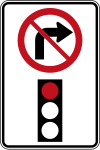
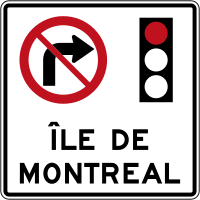
In Canada, a driver may turn right at a red light after coming to a complete stop unless a sign indicates otherwise. In the province of Quebec, turning right on a red was illegal until a pilot study carried out in 2003 showed that the right turn on red manoeuvre did not result in significantly more accidents. Subsequent to the study, the Province of Quebec now allows right turns on red except where prohibited by a sign. However, like in New York City, it remains illegal to turn right on a red anywhere on the Island of Montreal.[31] Motorists are reminded of this rule by large signs posted at the entrance to all bridges.
In Mexico, right turns on red are generally allowed unless a sign indicates otherwise.[32] Mexico City has implemented a new transit law which prohibits right turns on red.[33]
Left turn on red
[edit]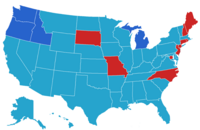
| Left turns on red from one-way and two-way streets into one-way streets permitted Left turns on red from one-way streets into one-way streets permitted State prohibits left turns on red |
In the U.S., 38 states allow left turns on red only if both the origin and destination streets are one way as of December 2018[update].[34]
Five states, namely Alaska,[35] Idaho,[36] Michigan,[37] Oregon,[38] and Washington[39] allow left turns on red into a one-way street from either a one-way street or a two-way street.
As of December 2018, the following states and territories ban left turns on red: Connecticut, Maine, Missouri, New Hampshire, New Jersey, North Carolina, Rhode Island, South Dakota (unless permitted by local ordinance), the District of Columbia, and Guam.[40] New York City prohibits left turn on red unless a sign indicates otherwise.[40]
In Canada, left turn on red light from a one-way road into a one-way road is permitted except in some areas of Quebec, New Brunswick, and Prince Edward Island. Left turn on red into a one-way road is permitted in British Columbia, even from a two-way road.[41]
Some intersections have signs to indicate that a left turn on red is prohibited. In BC,[42] Alberta,[43] Saskatchewan,[44] Manitoba,[45] and Ontario,[46] the sign for "no left turn" is defined with the line in the red circle flipped compared to other prohibitive signs. Although inconsistent, this allows "no left turn" to be a mirror image of "no right turn". However, in Quebec, the diagonal line is the same as in "no right turn".[47]
Central America
[edit]In Panama, right turns on red are not permitted. This was implemented due to safety concerns, one concern is that right on red can impose a serious accident to Pedestrians and Bicycles.[48]
South America
[edit]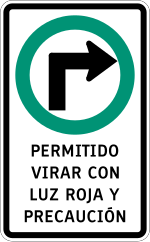
In Chile and Brazil, right turns on red are only allowed when a sign permitting it is shown.[citation needed] In Brazil, effective April 14, 2021.
Europe
[edit]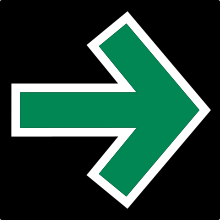
In Poland, right turns on red are permitted only if an additional green arrow light (apart from the main signal light) is present and lit. However, the regulations require drivers to stop completely, as their paths intersect with other vehicles or pedestrians in at least one direction. Green arrow light can be also directed left (the same regulations apply).[49]
In Germany, right turns on red are only permitted when a sign is present at the traffic light, after a complete stop. This rule was first introduced in 1978 in East Germany. It was derided as the "socialist right turn" in West Germany, which planned to eliminate it after German reunification in 1990.[50] However, a public backlash put an end to the plans, and the practice spread to the rest of Germany in 1994. Half of the 5,000 turn-on-red intersections that existed in 2002 were located in the former West Germany.[51]
In Switzerland, bicycles and small mopeds (Mofas) are allowed to turn right on certain red lights since 2021.[52] One does not have to come to a complete stop, but must yield to crossing pedestrians and traffic. During a pilot experiment preceding this change, wide acceptance and no accident were observed.[53]
In Slovenia, the same sign as in Germany is used,[54] where vehicles can turn right on a red light at all times, but they don't have the right of way. Some intersections also have a green arrow light, that is lit when right turns are allowed.[55][56] Historically, a different sign with the same meaning was used in the nineteen sixties, a green curved arrow on a small white rectangle board, attached under a traffic light.[57][58]
In Russia, right turns on red are only permitted if a separate arrow-shaped green light allows it; drivers must give way to any vehicle coming from a different direction. When the arrow is not lit, turns in the arrow direction are prohibited. However, in some cities, they have allowed turns on right provided there is a fixed green arrow with the writing below saying "Give way to everyone, you can turn on right".[59]
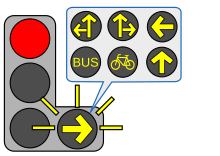
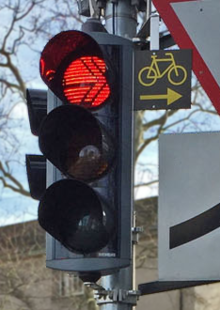
In France, a right turn on red without stopping is allowed when a separate arrow-shaped amber light flashes, but drivers do not have priority. They must check if any pedestrians are crossing before turning and must give way to vehicles coming from other directions. A sign can also permit cyclists to turn right on red.[60]
In Belgium, road signs that allow cyclists to turn right on a red light have been added to traffic law in 2012.[61] Such roads signs have been placed on intersections in the Brussels Capital Region.[62]
Like in the Netherlands, Belgium and France have a road sign that allows cyclists to turn right on a red light. The French and Belgian signs consist of a yield sign with a yellow bike and arrow inside. Such signs are placed under traffic lights.[63]
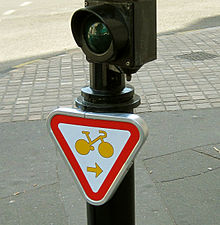
In the United Kingdom, which drives on the left, left turns on red are prohibited. At some junctions there is a separate left arrow-shaped green "filter" light which, when lit, allows left-hand turns but conflicting traffic will always have a red signal.[64] Other non conflicting traffic movements may have their own left or right arrow-shaped green light. Sometimes there are specific lanes without signals for turning left, separated from the through traffic signalled traffic by traffic islands, but give way signs are installed.
In Lithuania, drivers are allowed to turn right on red when a particular sign with a green arrow on a white background is mounted beside the red light of the traffic signal. However, on 10 November 2014, national traffic rules were altered meaning that this sign will be valid only until 31 December 2019 at the latest, by which time all such signs will have been eliminated. These changes were made for reasons of road safety.[65] The green arrows in Lithuania were eliminated on 1 January 2020. Despite the announcement of the date for the elimination of the green arrows in October 2014, many city administrations were not prepared for alternatives, which led to considerable public outrage in January 2020. The government has allowed the return of the green arrows in response to the situation, but each green arrow must be coordinated with the Transportation Literacy Agency. The agency carries out an assessment of a green arrow with regard to traffic safety and traffic capacity.
In Latvia, you are allowed to turn right/left on red when an additional section is present and lit on a traffic light. If the main signal is red and an additional signal is lit, you may pass to the direction of the arrow in the traffic light but you must give way to all traffic (including pedestrians). If the main signal is green and an additional signal is also lit, you may pass to any direction and you must comply with the standard intersection and junction traffic rules. If the main signal is green and the additional signal is not lit, you shall not turn to that direction. Logically, if the main signal is red and the additional signal is unlit - you shall not pass.
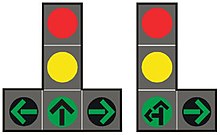
In the Czech Republic and Slovakia, right turns on red are allowed only when there is a lit green arrow present (called S 5 in Czech Republic and S 10 in Slovakia). Also in this case the car turning on red must give way to ongoing traffic, to pedestrians and other road users. (According to Czech law §70 of decree 30/2001 of Law Codex; and Slovak law §9, part 3g, decree 9/2009 of Law Codex.)
In Romania, right turns on red are only permitted if there is a small green flashing light with a right turn arrow. Drivers must yield to pedestrians and oncoming vehicles from their left. In some one-way junctions, the same rule applies for left on red (such as Cluj-Napoca Avram Iancu Square).
Asia
[edit]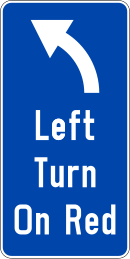
Similar to many former United Kingdom British Colonies, Hong Kong drives on the left. Left turns on red are always prohibited in Hong Kong.[66] At some junctions, however, there may be separate sets of signals for left turns, or specific lanes for turning left separating from the through traffic by traffic islands and give way signs are installed.
In China, right turns on red are generally permitted, unless there is a red arrow pointing to the right or otherwise indicated.[citation needed] Proceeding straight on red at T-intersections where the intersecting road went left only used to be legal in Mainland China, with right-hand traffic provided that such movement would not interfere with other traffic, but when the Road Traffic Safety Law of the People's Republic of China took effect on 1 May 2004, such movement was outlawed.[67]
In India, which drives on the left, a "free left turn" is generally prohibited.[68][69] However, some cities specifically permit turning left on a red signal.[70][71] An explicit green or blinking orange left signal also permits a turn on red, which usually means that conflicting traffic is not permitted to enter the same road.[72]
In Japan, which drives on the left, left turns on red require either a green left arrow signal along with the red light, or a white road sign with a blue left arrow (not to be confused with the one way sign).[73][74]
In the Republic of Korea, right turns on red are permitted after stop, unless signed as prohibited.[75]
In Lebanon, According to the new traffic law article number 69, turning right on red is legal unless there's a red arrow or a sign prohibiting it. [76]
In the Philippines, right turns on red are not explicitly allowed nor disallowed by the Land Transportation and Traffic Code as the code does not make any explicit reference to traffic lights.[77] However, in Metro Manila, local traffic codes indirectly allow vehicles to turn right at a red circle traffic light, where only left turns and going straight are prohibited.[78] The Filipino Driver's Manual, a driver's manual published by the Land Transportation Office, advises drivers that at intersections where right turns on red are permitted, they must first come to a complete stop and yield to pedestrians and cross-traffic vehicles.[79] Additionally, the Highway Safety Design Standards Manual of the Department of Public Works and Highways mandates the use of "No Right Turn on Red" signs at signalized intersections where such turns would cause conflict with other vehicles or pedestrians.[80] As such, it is generally accepted that right turns on red are allowed at a red circle traffic signal, except where a "No Right Turn on Red" sign or red arrow traffic signal is present.[81]
In Taiwan, right turns on red are always prohibited, except when there is a green arrow along with the red light. However, the right on red fine in Taiwan is lower than red light running fine.[82]
Oceania
[edit]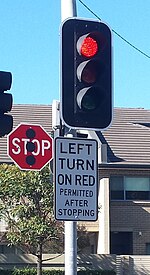
In Australia, which drives on the left, left turns on red are only permitted if a sign exists at the intersection. At such intersections, the sign generally reads "left turn on red permitted after stopping," meaning a vehicle can make a left turn only after coming to a complete stop first and giving way to approaching traffic and any crossing pedestrians or cyclists.[83][84] Such signs are only in limited locations in the states of New South Wales, South Australia, Northern Territory and Australian Capital Territory and are strictly banned in other states. In New South Wales, a number of tests to the intersection must be met before a turn on red will be permitted, including pedestrian volume, bus stop locations, geometry of the intersection, and the amount of lane changing at the intersection.[85] Queensland previously allowed left turns on red at certain intersections, but was scrapped in 2021 after a trial period found that the safety risk to pedestrians outweighed any time-saving benefits.[86] There are conflicting views on the policy of left turns on red, with supporters pointing to lower vehicle emission and time savings, while opponents cite safety concerns.[87][88]
In Samoa, which drives on the left, left turns on red are permitted.[89] Samoa used to drive on the right and basically follow the US rules of American Samoa, and this rule remained after switching to driving on the left on 7 September 2009.
Table
[edit]This table shows the legal status of turns on red in various jurisdictions, where no sign is present or traffic signal explicitly prohibits it. If it is normally allowed, a sign or red arrow might prohibit it. If it is normally disallowed, a sign or arrow might allow it, or the intersection may have a separate slip lane controlled by a yield or give way sign. However, a permissive arrow allowing a right turn (or left onto one-way) after yielding to traffic, possibly after a complete stop, is different from a protected arrow that does not require yielding.
| Country | Right (left) | Left (right) from one-way to one-way | Left (right) to one-way | Notes |
|---|---|---|---|---|
| North America | ||||
| Yes, except Island of Montreal | Yes, except some areas | only British Columbia | see #North America | |
| Yes, except New York City, where a sign only permits. | Yes, 38 states | Yes, 5 states | see #North America | |
| Yes, except Mexico City | No | |||
| Yes | No | except school buses and vehicles carrying hazardous materials | ||
| Central America | ||||
| Yes | No | |||
| No | ||||
| South America | ||||
| No | ||||
| only if sign permits | No | signs effective April 14, 2021 | ||
| only if sign permits | No | |||
| Yes | No | |||
| some towns | No | |||
| No | ||||
| No | ||||
| Europe | ||||
| only if arrow permits | No | bicycles may turn right on red if an arrow sign permits | ||
| only if sign permits | No | larger vehicles may not turn right on red, bicycles may turn right on red if a sign permits | ||
| No | ||||
| only if arrow permits | No | |||
| only if sign permits | No | |||
| only if arrow permits | No | bicycles may turn right on red if a sign permits | ||
| only if sign permits | No | |||
| No | ||||
| only if sign permits | No | |||
| No | ||||
| No | ||||
| only if sign permits | No | |||
| only if arrow permits | ||||
| only if sign permits | No | larger vehicles may not turn right on red, bicycles and mopeds may turn right on red if a sign permits | ||
| only if arrow permits | No | |||
| only if arrow permits | No | |||
| only if sign or arrow permits | No | |||
| only if arrow permits | No | |||
| only if sign permits | No | |||
| only if arrow permits | No | |||
| only if arrow permits | No | |||
| No | ||||
| Asia | ||||
| Yes | No | |||
| No | ||||
| No | ||||
| Yes | No | |||
| some cities | No | |||
| only if sign permits | No | |||
| Yes | No | |||
| only if sign permits | No | signs only in Sarawak and Putrajaya | ||
| Yes | No | |||
| Yes | No | |||
| only if sign permits | No | |||
| only if arrow permits | No | |||
| Yes | No | |||
| Africa | ||||
| No | ||||
| No | ||||
| only if sign permits | No | |||
| No | ||||
| No | ||||
| No | ||||
| No | ||||
| Oceania | ||||
| only if sign permits | No | |||
| No | ||||
| Yes | No | |||
Pedestrian and bicyclist safety
[edit]A 1981 US Department of Transportation study determined that the frequency of motor vehicle collisions with bicyclists and pedestrians when the vehicle was turning right increased significantly after the adoption of "Western RTOR". According to that study "Estimates of the magnitude of the increases ranged from 43% to 107% for pedestrian accidents and 72% to 123% for bicyclist accidents." These RTOR accidents were between 1% and 3% of all pedestrian and bicycle accidents in the locations that were studied.[90]
A 1984 study found that where RTOR was allowed "all right-turning crashes increase by about 23%, pedestrian crashes by about 60%, and bicyclist crashes by about 100%."[91] A 1993 study also concluded that RTOR increased crashes for pedestrians and cyclists, by 44% and 59% respectively.[92]
For the 1982–1992 period, a National Highway Safety Commission report estimated that total fatal crashes in the U.S. involving vehicles making a right turn on red, were between 0 and 84, and probably toward the lower end of the range.[93]
A February 2002 study published in the ITE Journal concluded that "Prohibiting right turn on red would require drivers to turn on green. This would most likely increase the number of collisions by right turning vehicles."[94][95]
A 2009 study by The New York City Department of Transportation of injuries before and after right turn on red was allowed at specific intersections concluded that the change had not affected accident rates.[96]
See also
[edit]References
[edit]- ^ "Driver's Manual" (PDF). New York State Department of Motor Vehicles. Archived from the original (PDF) on 9 October 2010.
- ^ "Laws of New York". New York State Legislature. Retrieved 16 May 2023.
Vehicle and Traffic § 1111. 2. Except in a city having a population of one million or more, unless a sign is in place prohibiting such turn:
- ^ "Laws of New York". New York State Legislature. Retrieved 10 May 2023.
Vehicle and Traffic § 1111. 5. Notwithstanding the provision of paragraph two of this subdivision, no school bus, while transporting pupils for any purpose, shall be permitted to proceed when facing a steady red signal.
- ^ "Signs and Signals: Right Turn on Red Restrictions". Safer Journey: Selecting Pedestrian Safety Improvements. United States Federal Highway Administration. n.d. Retrieved 23 May 2023.
- ^ "U.S. cities consider banning "right on red" laws amid rise in pedestrian deaths - CBS News". CBS News. 4 November 2023.
- ^ Cantor, Matthew (17 October 2023). "US pedestrian deaths are soaring. Is it time to ban right turns on red lights?". The Guardian. ISSN 0261-3077.
- ^ "As pedestrian deaths reach 40-year high, right-on-red comes under scrutiny nationwide". USA TODAY. 2023.
- ^ "Energy Policy and Conservation Act". govtrack.us.
- ^ Rabinovitz, Jonathan D (4 December 1979). "Right-On-Red Comes to Boston". The Harvard Crimson. Retrieved 1 July 2017.
- ^ Times, Michael Knight Special to The New York (30 December 1979). "For Boston Drivers It's Turn Right on Red and Full Speed Ahead". The New York Times. Retrieved 11 August 2022.
- ^ Edgar B. Herwick III (3 November 2021). "Who Decides If You Can or Can't Turn Right On Red While Driving? | The Curiosity Desk". WGBH Educational Foundation.
- ^ "Right Turn on Red" (PDF). Sustainable Streets Index. New York City Department of Transportation. 2009.
- ^ "A Major City Moves to Ban Right Turns on Red". Route 50. 5 October 2022. Retrieved 11 January 2023.
- ^ "B24-0673 - Safer Intersections Amendment Act of 2022 (now known as "Safer Streets Amendment Act of 2022")". Council of the District of Columbia. Retrieved 16 May 2023.
- ^ "No Right Turn on Red Is Now the Default in Seattle". theurbanist.org. 4 May 2023. Retrieved 30 May 2023.
- ^ 13 AAC (Alaska Administrative Code) 02.010(a)(3)(C)
- ^ California Vehicle Code §21453(c)
- ^ Colorado Revised Statutes §42-4-604(1)(c)(III)
- ^ Georgia Code §40-6-21(a)(3)(F)
- ^ Idaho Statutes §49-802(3)(c)
- ^ Maine Revised Statutes Title 29-A, §2057(1)(C-1)
- ^ Minnesota Statutes §169.06, subdivision 5(3)(iii)
- ^ "Chapter 4: Traffic Control". Online Driver's Manual and Study Guide. New York State Department of Motor Vehicles. 25 November 2013.
- ^ "Vermont Laws". legislature.vermont.gov. Retrieved 18 October 2024.
No motorist shall turn right when facing a red arrow signal indication unless a regulatory sign is present that permits this movement.
- ^ Code of Virginia §46.2-835, §46.2-836
- ^ District of Columbia Municipal Regulations §18-2103.8
- ^ Ley de Vehículos y Tránsito: Artículo 8.02(d)(5)
- ^ "Frequently Asked Questions - Traffic Signals". Florida Department of Transportation. Retrieved 18 October 2024.
After stopping, you may turn RIGHT on the red arrow at most intersections if the way is clear. Some intersections display a "NO TURN ON RED" sign, which you must obey.
- ^ Legislature, O. R. "ORS 811.360 – Vehicle turns permitted at stop light". oregon.public.law. Retrieved 18 October 2024.
The driver of a vehicle, subject to this section, who is intending to turn at an intersection where there is a traffic control device showing a steady circular red signal, a steady red bicycle signal or a steady red arrow signal may do any of the following without violating ORS 811.260 (Appropriate driver responses to traffic control devices) and 811.265 (Driver failure to obey traffic control device)
- ^ "Right Turn on Red" (PDF). nyc.com. Archived from the original (PDF) on 4 March 2011. Retrieved 22 January 2010.
- ^ "Transports Québec: Right Turn on Red". mtq.gouv.qc.ca. Archived from the original on 16 July 2011.
- ^ Estado de Mexico Archived 4 March 2016 at the Wayback Machine
- ^ "Adiós a la vuelta continua y multas por usar el teléfono, así el nuevo Reglamento de Tránsito del DF – Animal Político". 17 August 2015. Retrieved 28 October 2016.
- ^ "Bill in Missouri Legislature would let drivers turn left during red light". Missourinet. 26 December 2018. Retrieved 25 November 2019.
The bill would allow for left turns during a red light when the vehicle is in the left-most lane on a one-way street turning onto another one-way street. Thirty-eight states currently permit the move.
- ^ "DOC Frame Page". Legis.state.ak.us. Retrieved 28 October 2016.
- ^ "Idaho Legislature - Section 49-802". Retrieved 5 August 2023.
- ^ "Michigan Legislature – Section 257.612". Retrieved 28 October 2016.
- ^ Njus, Elliot (22 October 2015). "Turn left on red? The devil's in the details (Commuting Q&A)". oregonlive. Retrieved 25 November 2019.
- ^ "RCW 46.61.055: Traffic control signal legend". Retrieved 28 October 2016.
- ^ a b "Bill in Missouri Legislature would let drivers turn left during red light". Missourinet. 26 December 2018. Retrieved 25 November 2019.
- ^ BC Motor Vehicle Act Archived 20 September 2016 at the Wayback Machine, Section 129
- ^ "Regulatory Signs" (PDF). 2.gov.bc.ca. Retrieved 10 May 2022.
- ^ "Prohibitive signs". Alberta.ca. Retrieved 10 May 2022.
- ^ "Saskatchewan Driver's Handbook". Sgi.sk.ca. Retrieved 10 May 2022.
- ^ "Manitoba Driver's Handbook - Regulatory Signs". Apps.mpi.mb.ca. Retrieved 10 May 2022.
- ^ "Signs". Ontario.ca. Retrieved 10 May 2022.
- ^ "GAZETTE OFFICIELLE DU QUÉBEC, June 23, 1999, Vol. 131, No. 25" (PDF). 2.publicationsduquebec.gouv.qc.ca. Retrieved 10 May 2022.
- ^ "Autoridad de Tránsito de Panamá". twitter.com. Retrieved 3 August 2023.
- ^ Rozporządzenie Ministrów Infrastruktury oraz Spraw Wewnętrznych i Administracji z dnia 31 lipca 2002 r. w sprawie znaków i sygnałów drogowych Archived 30 March 2016 at the Wayback Machine, § 96.1. and 96.3.
- ^ Fisher, Marc (1 October 1990). "Anxiety Spreads in East". The Washington Post.
- ^ "The Green Arrow". German Pedestrians' Association (FUSS e.V.). Retrieved 28 January 2021.
- ^ "Neue Verkehrsregeln ab 1. Januar 2021". Admin.ch. Retrieved 19 April 2022.
- ^ "Pilotversuch für velofreundliche Lichtsignalanlagen erfolgreich abgeschlossen". Bvd.bs.ch (in German). Retrieved 19 April 2022.
- ^ "Pravilnik o prometni signalizaciji in prometni opremi na javnih cestah". Uradni List - Služba Vlade RS za zakonodajo (in Slovenian). 2016. p. 56. Retrieved 25 August 2021.
2444 — Vožnja desno ob rdeči luči na semaforju
- ^ "2630. Zakon o spremembah in dopolnitvah Zakona o pravilih cestnega prometa (ZPrCP-F)" (PDF). Uradni List - Služba Vlade RS za zakonodajo (in Slovenian). 27 July 2021. p. 7706. Retrieved 25 August 2021.
- ^ "Zakon o pravilih cestnega prometa (ZPrCP)". Legal Information System of the Republic of Slovenia (PISRS) (in Slovenian). 27 July 2021. p. 62. Retrieved 25 August 2021.
99. člen — (1) — 2. rdeča luč in prometni znak za vožnjo desno ob rdeči luči na semaforju – dovoljena vožnja desno ob rdeči luči na semaforju, če je smer prosta
- ^ Right-turn-on-red traffic sign in Prešeren square, Ljubljana, cca 1969 (Television production). Ljubljana. 1969. Retrieved 28 December 2021.
- ^ Right-turn-on-red traffic sign in Prešeren square, Ljubljana, cca 1969 (closeup) (Television production). Ljubljana. 1969. Retrieved 28 December 2021.
- ^ Правила дорожного движения Российской Федерации Archived 13 November 2016 at the Wayback Machine, п.6.3
- ^ Arrêté du 24 novembre 1967 relatif à la signalisation des routes et des autoroutes – Article 7. "Arrêté du 24 novembre 1967 relatif à la signalisation des routes et des autoroutes - Article 7 | Legifrance". Archived from the original on 12 April 2016. Retrieved 2 October 2015.
- ^ "LOI - WET". Ejustice.just.fgov.be. Retrieved 10 May 2022.
- ^ "Brussel plaatst 100 extra borden waar fietser door het rood mogen rijden". Het Laatste Nieuws. Retrieved 15 June 2015.
- ^ Trotignon, Jean-Michel. "Tourne à droite au feu rouge: il manque juste le panneau" (PDF). Vélocité. Fédération française des Usagers de la Bicyclette. Retrieved 16 July 2011.
- ^ "The Highway Code: Using the road (rule 177)". Retrieved 26 June 2015.
- ^ "Changes of Lithuanian Traffic rules on 3 October 2014 – valid from 10 October 2014" (in Lithuanian). Archived from the original on 23 November 2014.
- ^ "Cap. 374G Road Traffic (Traffic Control) Regulations Part III: Light Signals". Hong Kong eLegislation. Retrieved 16 August 2023.
- ^ "Traffic Light Signals and Red Light Cameras". Geocities.com. Archived from the original on 24 October 2009. Retrieved 19 May 2009.
- ^ Adhiraj Joglekar (8 May 2007), Driving in India: At Red Lights There are no Free Left Turns, retrieved 4 November 2016
- ^ "Common Traffic Rules". India Study Channel. 30 August 2009. Retrieved 4 November 2016.
- ^ Ramu, Marri (26 December 2015). "For a change, it's a hassle-free ride". The Hindu. ISSN 0971-751X. Retrieved 5 November 2016.
- ^ "Chandigarh traffic police, promoting road safety, traffic safety, India road signs & rules, safe responsible driving, first aid India". Candigarhtrafficpolice.org. Retrieved 5 November 2016.
- ^ "Did govt change the "No Free Left" Rule, off late – Team-BHP". Team-BHP.com. Retrieved 5 November 2016.
- ^ "道路交通法施行令 第二条". Retrieved 23 June 2022.
- ^ "交通規制基準" (PDF). p. 177. Retrieved 23 June 2022.
- ^ Bae Jae-Sung (20 April 2023). "Cars must stop before making a right on red, new Korean traffic law says". Joongang Daily. Retrieved 11 May 2023.
- ^ Article 69, Traffic Law of Lebanon (PDF),
It is permitted for vehicles to turn right at a red signal, provided that they stop at the signal and then secure their turn without exposing pedestrians and other traffic to any danger and provided that there is no signal prohibiting it.
| date=22 October 2012 - ^ Republic Act No. 4136 (20 June 1964), Land Transportation and Traffic Code, archived from the original on 30 August 2023, retrieved 30 August 2023
- ^ "Draft Traffic Code". SSTRIMM Final Report (PDF). Japan International Cooperation Agency. November 2001. p. A-7.
- ^ Filipino Driver's Manual (PDF). Vol. 1 (2nd ed.). Land Transportation Office. 2021.
- ^ DPWH Highway Safety Design Standards Manual - Part 2: Road Signs and Pavement Markings Manual. Department of Public Works and Highways. May 2012.
- ^ "Right turn on red: when and when not to?". AutoDeal. 17 January 2022. Retrieved 25 May 2024.
- ^ Article 53, Road Traffic Management and Penalty Act, Taiwan, retrieved 3 March 2022,
Should a car driver pass through an intersection with signal control without following the signal instruction and run a red light he/she shall be fined from NT$1,800 to NT$5,400. Should the driver as detailed in the above paragraph make a right turn during a red light, he/she shall be fined from NT$600 to NT$1,800.
- ^ "Traffic lights and road markings – Safety & Rules". Roads and Maritime Services. Archived from the original on 14 October 2016. Retrieved 14 October 2016.
- ^ "Left Turn on Red project". Brisbane City Council. Archived from the original on 14 October 2016. Retrieved 14 October 2016.
- ^ "Traffic Signal Design: Appendix E Left Turn on Red" (PDF). NSW Government Roads and Maritime Services. 14 July 2016.
- ^ Stone, Lucy (31 May 2021). "Queensland government ends 'left-turn-on-red' traffic light rule". ABC News (Australia). Retrieved 21 May 2024.
- ^ "Call to allow left-hand turns on red lights in SA". ABC News. 24 July 2016. Retrieved 14 October 2016.
- ^ Acott, Kent (27 April 2014). "Turn left on red possible solution". The West Australian. Retrieved 14 October 2016.
- ^ "Samoa Road Rules | Driving | Samoa | Pacific Island Holiday". Samoa.travel.
- ^ D. F. Preusser; W. A. Leaf; K. B. DeBartolo; R. D. Blomberg (October 1981). The Effect of Right-Turn-On-Red on Pedestrian and Bicyclist Accidents (PDF) (Report). US.Department of Transportation National Highway Traffic Safety Administration. p. vii. Retrieved 5 February 2019.
- ^ Zador, Paul (August 1984). "Right-turn-on-red laws and motor vehicle crashes: A review of the literature". Accident Analysis & Prevention. 16 (4): 241–245. doi:10.1016/0001-4575(84)90019-8.
- ^ Dussault, Claude (14–16 June 1993). Safety Effects of Right Turn on Red: A Meta Analysis. Proceedings of the Canadian Multidisciplinary Road Safety Conference VIIII. Saskatoon, Saskatchewan.
- ^ National Highway Traffic Safety Administration (February 1995). "The Safety Impact of Right Turn on Red - Report to Congress". one.nhtsa.gov. Retrieved 3 November 2022.
- ^ Fleck, Jack L.; Yee, Bond M. (19 February 2002). "Safety Evaluation of Right Turn on Red" (PDF). San Francisco Municipal Transportation Agency. Retrieved 3 November 2022.
- ^ ITE Journal, Volume: 72, Issue Number: 6; Publisher: Institute of Transportation Engineers (ITE); ISSN: 0162-8178; Publication Date: 2002-6; pages 46-48
- ^ New York City Department of Transportation (2009). "Right Turn on Red" (PDF).
External links
[edit]- The Safety Impact Of Right Turn On Red: Report To Congress, National Highway Traffic Safety Administration Traffic Tech
- Sarkar, Sheila; Van Houten, Ron; Moffatt, John (1 January 1999). "Using License Manuals To Increase Awareness About Pedestrian Hazards at Intersections. Missed Opportunity for Educating Drivers". Transportation Research Record: Journal of the Transportation Research Board. 1674: 49–56. doi:10.3141/1674-07. ISSN 0361-1981. S2CID 111367210. Transportation Research Record 1674.
- Traffic Light Signals and Red Light Cameras: Turning on Red Light (US), by Justin JIH.
